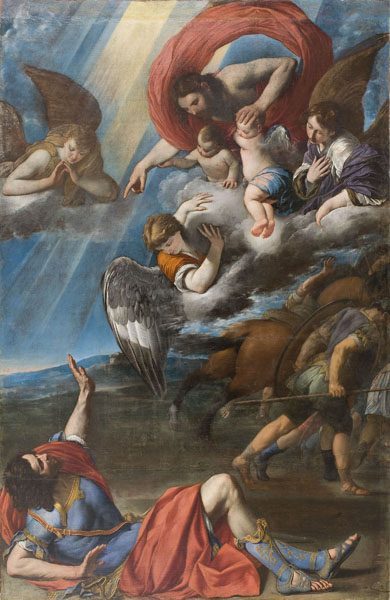The Conversion of Saint Paul (Maíno) facts for kids
Quick facts for kids The Conversion of Saint Paul |
|
|---|---|
| Spanish: La conversión de san Pablo | |
 |
|
| Artist | Juan Bautista Maíno |
| Year | 1614 |
| Type | Oil on canvas |
| Dimensions | 244.5 cm × 157 cm (96.3 in × 62 in) |
| Location | National Museum of Art of Catalonia |
The Conversion of Saint Paul (Spanish: La conversión de san Pablo) is a famous painting from 1614. It was created by the artist Juan Bautista Maíno. You can find this artwork at the National Museum of Art of Catalonia (MNAC).
Experts officially said Maíno painted this work in 2011. It was carefully restored in 2012. This restoration was supported by the international bank BNP Paribas.
This painting is one of the few works still existing by Maíno. He is known for bringing the painting style of Caravaggio to Spain. Caravaggio and other Roman painters were very popular in the early 1600s. The MNAC also has another painting by Maíno. It is a portrait of Fray Alonso de Santo Tomás from 1648–1649. This was one of Maíno's last artworks.
Contents
How the Painting Was Discovered
The Conversion of Saint Paul shows the amazing quality of Maíno's art. This style comes from the years he lived in Rome. When he came back to Spain, Maíno did not just copy what he saw. He used new ideas to make his own unique art. This way of bringing new art styles from his travels made his work special. It was different from other artists of his time.
The former Museum of Art of Catalonia bought this painting in 1952. John Ainaud Lasarte, who was a director of art museums in Barcelona, was very interested in it. At first, Ainaud thought an Italian artist, maybe Orazio Gentileschi, painted it. Later, it was thought to be by a Spanish painter named José Vergara.
However, after more research, experts finally said Maíno was the true artist. This new discovery is very important. It helps us understand Spanish painting from the 1600s much better. Sadly, a fire in 1985 badly damaged the painting.
What Is Maíno's Painting Style?
In this painting, you can see how talented Maíno was. He used strong lines and careful brushstrokes. The people in the painting look like sculptures. He made them look this way by using light and dark colors that stand out.
The Conversion of Saint Paul shows how much Maíno learned from Italian art. He found a lot of artistic ideas in Rome. He lived there between 1605 and 1610. The painting also shows the influence of Caravaggio. You can see this in how the hair is painted. Also, the angels and the serious face of Jesus look like Caravaggio's style.
The face of Jesus in this painting is very similar to the main figure in Maíno's Trinity painting. The Trinity was part of a large altarpiece. Maíno made this altarpiece for a convent in his hometown of Pastrana.
How the Painting Was Restored
The Conversion of Saint Paul was in bad shape. It had been changed and repainted over time. A fire on April 1, 1985, made things worse. This fire happened in a Barcelona office where the painting was displayed. The painting got very hot, which caused bubbles and big missing parts. A dark layer also covered the painting, making it hard to fix.
To understand the damage, experts used special tools. They studied the painting's layers, drawing, and colors. This helped them figure out the best way to restore it. Radiography was used to see what the painting looked like before the fire. It showed strong lines and clear light and shadow. This helped experts understand Maíno's original work. It also showed areas where the paint had worn off.
The painting's size had also been changed. A piece of canvas, about 7.5 centimeters (3 inches) wide, was added to the right side. This piece actually came from the top of the painting, which had been cut off earlier. This change happened before the painting came to the museum in 1952. Old photos of the museum show this. Experts found a piece of newspaper when they unframed the painting. This newspaper helped them date the change to May 15, 1945. It was a page from La Prensa newspaper.
The restoration process also allowed experts to study the materials Maíno used. They learned about his painting techniques. They studied the colors and how he applied them to create light and shadows. They also looked at the chemical makeup of his earth-based paints. These materials matched those found in other Maíno paintings. Those other works were studied at the Museo del Prado for an exhibition in 2009–2010.
Sources
- Quilez, Francesc i Mestre, Mireia La conversió de sant Pau. Atribució i restauració. La recuperació d’una pintura per al MNAC MNAC, July 2012. ISBN: 978-84-8043-254-2
- Leticia Ruiz Gómez (ed.), Juan Bautista Maíno, Museo Nacional del Prado/Ediciones El Viso (2009), ISBN: 978-84-8480-190-0
See also
 In Spanish: La conversión de san Pablo (Maíno) para niños
In Spanish: La conversión de san Pablo (Maíno) para niños

